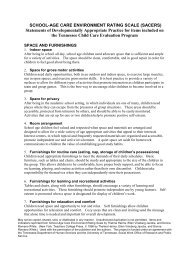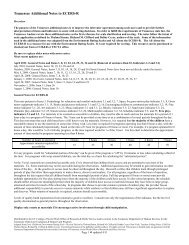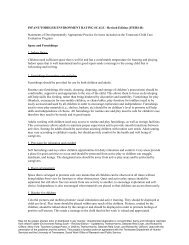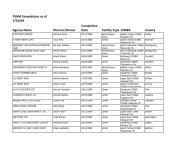Environment Rating Scales - Star-Quality Program
Environment Rating Scales - Star-Quality Program
Environment Rating Scales - Star-Quality Program
You also want an ePaper? Increase the reach of your titles
YUMPU automatically turns print PDFs into web optimized ePapers that Google loves.
FACT SHEET: <strong>Environment</strong> <strong>Rating</strong> <strong>Scales</strong><br />
Using the<br />
<strong>Environment</strong><br />
<strong>Rating</strong><br />
<strong>Scales</strong> to<br />
Measure<br />
Child Care<br />
<strong>Quality</strong><br />
T en nessee has chosen to use the <strong>Environment</strong> <strong>Rating</strong> <strong>Scales</strong> to assess<br />
the quality of child care programs in our state. According to Dr. Thelma<br />
Harms, one of the authors of the <strong>Environment</strong> <strong>Rating</strong> <strong>Scales</strong>, all children<br />
have three basic needs:<br />
1. Protection of health and safety<br />
2. Building relationships with children, parents, extended family, and<br />
community<br />
3. Opportunities for stimulation and learning from experience<br />
We must consider all three of these basic needs when developing child<br />
care programs, when evaluating the quality of such programs, and when<br />
designing initiatives to improve them. These needs are constant across childhood—regardless of<br />
race, ethnicity, culture, or socio-economic background. The <strong>Environment</strong> <strong>Rating</strong> <strong>Scales</strong> are tools<br />
that can be used to assess a child care provider’s ability to address these three basic needs. The<br />
rating scales measure staffing patterns, schedule, policies, curriculum, supervision, parent<br />
involvement, and overall environment.<br />
While children of all ages and backgrounds have the same three basic needs, the expression of<br />
those needs—and thus the environment that best nurtures them—changes as children grow.<br />
Consequently, four different scales, each carefully designed to address a different segment of the<br />
early childhood field, are used to assess the environment in which providers care for children:<br />
ITERS-R for children from birth through 2½ years of age; ECERS-R for children in their preschool<br />
years (2½–5 years); SACERS for elementary school ages (K–5 th grade); and FCCERS-R for family<br />
home and group care.<br />
All four scales have been tested extensively, used widely, and are well respected in both<br />
academia and the field. For example, the ECERS and ITERS were used as the comprehensive<br />
quality measures in the National Child Care Staffing Study (Whitebook, Howes, & Phillips, 1989)<br />
and in the Cost, <strong>Quality</strong>, and Child Outcomes Study (1995)—both major studies of their time.<br />
Similarly, FDCRS was used in the Study of Children in Family Child Care and Relative Care<br />
(Galinsky, Howes, Kontos, & Shinn, 1994). In all of these studies, a relationship was found<br />
between higher scores on the scales and more positive child development outcomes in areas that<br />
are considered important for later school success. In fact, the effects of higher quality<br />
experiences during early childhood have been shown to last at least through the second grade of<br />
elementary school (Peisner-Feinberg, Burchinal, Clifford, Culkin, Howes, Kagan, Yazejian, Byler,<br />
Rustici, & Zelazo, 1999). Research is continuing to evaluate longer-lasting effects.<br />
Avoiding<br />
Cultural<br />
Bias<br />
Avoiding cultural bias in any assessment tool is absolutely essential. The<br />
<strong>Environment</strong> <strong>Rating</strong> <strong>Scales</strong> have been proven unbiased in a variety of<br />
studies in culturally diverse settings. For example, the ECERS-R (1998,<br />
revised edition of the original 1980 ECERS), is currently being used in<br />
several major studies, including the Early Head <strong>Star</strong>t Study (Mathematica<br />
Corporation) and Welfare, Children and Families: A Three City Study<br />
(Columbia University, University of Chicago, and Harvard University). The original ECERS was<br />
used in the Head <strong>Star</strong>t FACES study, which included over 400 classrooms nationwide. The<br />
preliminary results from all these studies show that the ECERS and the ECERS-R are performing<br />
very well as unbiased assessment tools. Moreover, the ECERS scale has been used as a<br />
program improvement tool in many different settings, including those serving culturally diverse<br />
populations and in inclusive programs.<br />
It is also interesting to note that the scales have been used in research studies and program<br />
improvement efforts in many other countries including Canada, Germany, Italy, Sweden, Russia,<br />
Iceland, Portugal, England, Spain, Austria, Singapore, Hong Kong, Korea, Hungary, and Greece.<br />
They have been proven reliable and valid in each country with relatively minor adaptations. While<br />
there are some differences between various countries, each adheres to a core set of child<br />
Tennessee Child Care Report Card<br />
Prepared for Tennessee Department of Human Services<br />
and <strong>Star</strong> <strong>Quality</strong> <strong>Program</strong><br />
by UT Social Work Office of Research & Public Service<br />
<strong>Environment</strong> <strong>Rating</strong> <strong>Scales</strong> Fact Sheet Revised 2011
FACT SHEET: <strong>Environment</strong> <strong>Rating</strong> <strong>Scales</strong><br />
development goals and early childhood practices common to most modern, industrialized<br />
countries (Tietze, et al, 1996). In England, Greece, Germany, Portugal, Spain, and Austria, it has<br />
been shown that higher scores on the scales are related to more positive child development<br />
outcomes (Petrogannis & Melhuish, 1996; European Child Care and Education Study Group,<br />
1997). This provides further evidence that children from many backgrounds require similar<br />
practices for success in the developmental areas that western industrialized countries value.<br />
R el iability means measuring the same thing, the same way, every<br />
time. Each of the four <strong>Environment</strong> <strong>Rating</strong> <strong>Scales</strong> has undergone<br />
Reliability and<br />
Validity of the<br />
<strong>Scales</strong><br />
extensive field testing to insure inter-rater reliability, test-retest reliability,<br />
and internal consistency. The scales have been revised as necessary to<br />
achieve reliability at both the micro level (each item that is assessed)<br />
and macro level (the combined scores of all items). Inter-rater reliability,<br />
the degree of agreement between two different assessors’ independent ratings, is achieved in the<br />
field through proper training of assessors and ongoing monitoring to be sure assessors are all<br />
using the scales consistently.<br />
As with reliability, there are a number of different approaches to determining validity. For<br />
example, validity can be checked by outcomes, by comparison to other tools, and by the use of<br />
that tool in reputable studies. The <strong>Environment</strong> <strong>Rating</strong> <strong>Scales</strong> meet all these criteria. During<br />
testing, the scales were found to correlate positively with both observed behaviors and regulated<br />
aspects of a child care environment. Criterion validity of the scales has been demonstrated in<br />
comparisons with other well-known tools for assessing quality, environment, and opportunities<br />
within a program. A panel of child development experts established content validity by<br />
determining that scale items are important to child care and relevant to the scales themselves.<br />
And finally, the reliability and validity of the <strong>Environment</strong> <strong>Rating</strong> <strong>Scales</strong> has been reinforced by<br />
the number of studies that support using them as tools for assessing levels of quality in child care<br />
environments.<br />
B ey ond the academic questions of validity and reliability, we all want to<br />
Consistent be sure that, when a provider’s program is assessed, that assessment<br />
Application is accurate and fair. With that goal in mind, Tennessee’s Department of<br />
of the<br />
Human Services has hired professional, highly qualified assessors who<br />
are knowledgeable in the field of child development. The rigorous training<br />
<strong>Scales</strong><br />
program for these assessors begins with classroom and field<br />
training in which assessors learn about using the scales<br />
to measure the quality of child care programs. Training continues with multiple practice<br />
observations, in which assessors use the scales in real child care facilities under the direction of<br />
trained and reliable assessment specialists and training staff from the University of Tennessee<br />
(UT) College of Social Work. Once this initial training is over, assessors continue to have their<br />
individual reliability checked by an assessment specialist every sixth time they use a particular<br />
scale. This check-and-recheck strategy will insure that each scale is used consistently and fairly<br />
throughout the state regardless of the particular assessor assigned. Furthermore, the assessment<br />
program staff will continue to seek guidance from the rating scales’ authors and<br />
other scales experts at the University of North Carolina, Chapel Hill. This strategy will help us<br />
ensure that the assessment program staff are well trained and the assessment program is<br />
unbiased and fair.<br />
Providers, parents—all of us—can be confident of the results of an assessment. The demanding<br />
and ongoing training and support that assessors receive will serve to guarantee that the scores a<br />
center or home receives are based on that facility and not on its location, program type, or<br />
assessor. The carefully designed scoring process and continued support and training leave little<br />
room for personal biases to intrude upon the overall scoring process.<br />
Copies of the <strong>Environment</strong> <strong>Rating</strong> <strong>Scales</strong> can be purchased from the following web site:<br />
www.fpq.unc.edu/products/<br />
Tennessee Child Care Report Card<br />
Prepared for Tennessee Department of Human Services<br />
and <strong>Star</strong> <strong>Quality</strong> <strong>Program</strong><br />
by UT Social Work Office of Research & Public Service<br />
<strong>Environment</strong> <strong>Rating</strong> <strong>Scales</strong> Fact Sheet Revised 2011
















